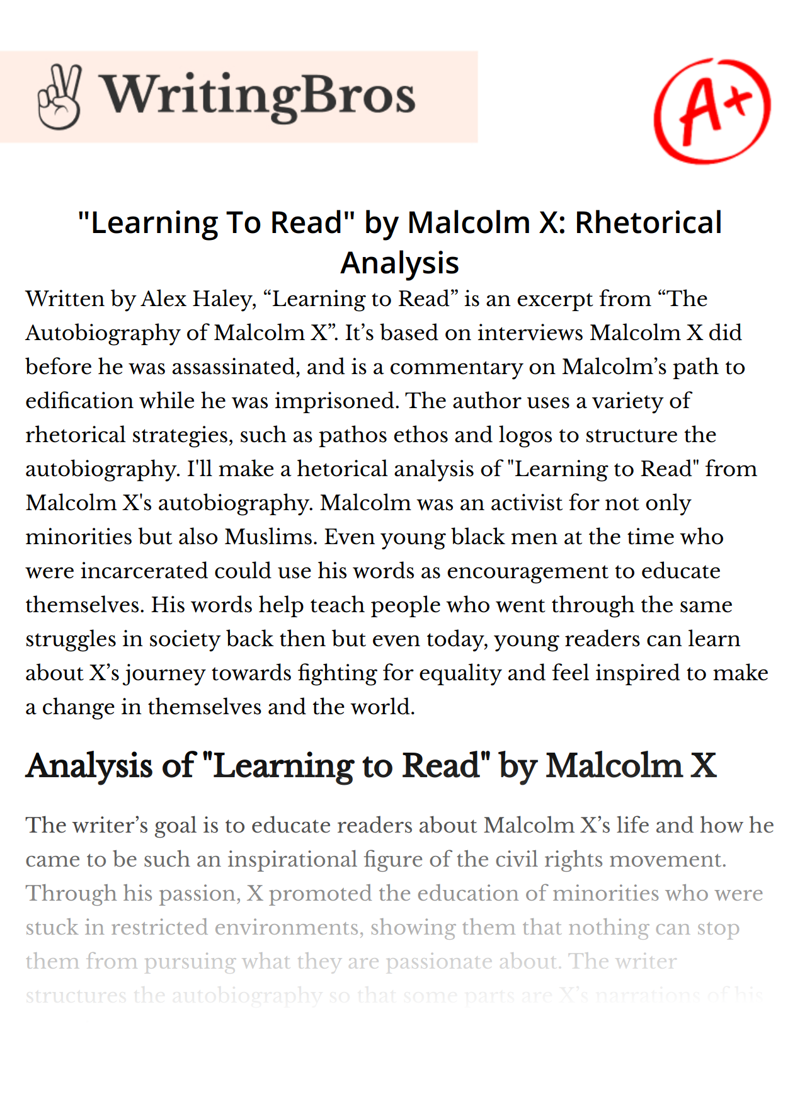"Learning To Read" by Malcolm X: Rhetorical Analysis

Written by Alex Haley, “Learning to Read” is an excerpt from “The Autobiography of Malcolm X”. It’s based on interviews Malcolm X did before he was assassinated, and is a commentary on Malcolm’s path to edification while he was imprisoned. The author uses a variety of rhetorical strategies, such as pathos ethos and logos to structure the autobiography. I'll make a hetorical analysis of "Learning to Read" from Malcolm X's autobiography.
Malcolm was an activist for not only minorities but also Muslims. Even young black men at the time who were incarcerated could use his words as encouragement to educate themselves. His words help teach people who went through the same struggles in society back then but even today, young readers can learn about X’s journey towards fighting for equality and feel inspired to make a change in themselves and the world.
Analysis of "Learning to Read" by Malcolm X
The writer’s goal is to educate readers about Malcolm X’s life and how he came to be such an inspirational figure of the civil rights movement. Through his passion, X promoted the education of minorities who were stuck in restricted environments, showing them that nothing can stop them from pursuing what they are passionate about. The writer structures the autobiography so that some parts are X’s narrations of his experiences and his recounting of the details of the important parts of his life. It is then shifted as Malcolm dives deeper into his realizations of the things he had read in prison, in order to display Malcolm’s arguments and philosophies. Haley writes that Malcolm, prior to being incarcerated, said that “in the street, I had been the most articulate hustler out there. I had commanded attention when I said something. But now, trying to write simple English, I not only wasn’t articulate. I wasn’t even functional.” This is an example of the appeal of ethos in Malcolm’s story.
Despite not having an education, Malcolm was able to connect with his audience using his street-smarts. Haley uses pathos in order to illustrate to the audience the importance of achieving an education. Throughout the book, Malcolm is frustrated that he is unable to communicate his ideas and philosophies to others due to his lack of education. Malcolm feels like he’s on the inside looking out, as if being inarticulate means he’s virtually speechless. Malcolm, now known as a brilliant orator and debater, struggled to write. Knowing this, the audience can relate to him and understand that they too can become exceptional at writing, communicating and articulating, no matter where they start. Using logic, Haley is able to persuade the audience to seek out education, and that knowledge can open up a whole new world. Malcolm, while in prison, took it upon himself to go to the prison library and try to read, after going through the dictionary and copying words down. For Malcolm, reading was like escaping prison. In conclusion, the author uses a variety of rhetorical strategies to structure the autobiography of Malcolm X’s path to enlightenment through self-education and perseverance in difficult.
In addition to ethos, pathos, and logos, Alex Haley also employs other rhetorical devices to craft an impactful narrative in “Learning to Read”. One such device is imagery, which is used to create vivid mental pictures in the reader's mind. For instance, when Malcolm X describes his frustration with not being able to express himself clearly due to his lack of education, he says, “I felt like a fool, not able to speak to anyone, and unable to say anything that made sense.” This evokes a sense of helplessness and despair in the reader, making them empathize with Malcolm’s struggle.
Another rhetorical device used in the essay is repetition. Malcolm X repeats the phrase “by any means necessary” several times throughout the text to emphasize the urgency and necessity of the fight for racial justice. This phrase becomes a rallying cry for those who share his beliefs and is still used today as a symbol of resistance against oppression.
Haley also employs rhetorical questions, which are questions asked for effect rather than to elicit an answer. For example, he asks, “What is a Muslim who isn’t praying, fasting, and following the teachings of the Messenger?” This question challenges readers to think critically about their own beliefs and actions and to consider the importance of religious practice and devotion.
In conclusion, the rhetorical strategies used in “Learning to Read” help to create a powerful and inspirational narrative about Malcolm X’s journey to self-education and advocacy for minority rights. Haley’s use of ethos, pathos, logos, imagery, repetition, and rhetorical questions all work together to engage the reader and convey the importance of education, perseverance, and the fight for equality. The essay continues to resonate with readers today, inspiring them to take action and make a positive change in their communities.
References
- X, M. (1965). The autobiography of Malcolm X. Ballantine Books.
- Schlesinger, A. M., & Israel, F. (1992). A thousand days: John F. Kennedy in the White House. Houghton Mifflin Harcourt.
- Bloom, H. (Ed.). (2009). Malcolm X. Infobase Publishing.
- D’Souza, D. (2018). The big lie: Exposing the Nazi roots of the American left. Regnery Publishing.
- Foner, P. S. (2012). The story of American freedom. WW Norton & Company.
- Haley, A. (1992). The autobiography of Malcolm X: As told to Alex Haley. Ballantine Books.
- Horne, G. (2011). The counter-revolution of 1776: Slave resistance and the origins of the United States of America. NYU Press.
Cite this Essay
To export a reference to this article please select a referencing style below

